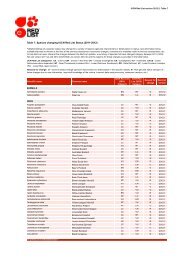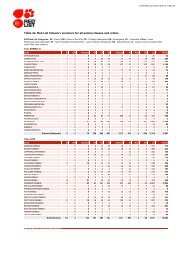IUCN Red List Guidelines - The IUCN Red List of Threatened Species
IUCN Red List Guidelines - The IUCN Red List of Threatened Species
IUCN Red List Guidelines - The IUCN Red List of Threatened Species
You also want an ePaper? Increase the reach of your titles
YUMPU automatically turns print PDFs into web optimized ePapers that Google loves.
<strong>Red</strong> <strong>List</strong> <strong>Guidelines</strong> 48<br />
5.8 Taxa with Widely Distributed or Multiple Populations<br />
This section addresses the issues related to the presentation and use <strong>of</strong> the information from<br />
subpopulations (or from parts <strong>of</strong> the range) <strong>of</strong> a widely distributed taxon, in assessing the<br />
taxon against <strong>IUCN</strong>’s criterion A. For such taxa, it is recommended that the available data<br />
on past reduction be presented in a table that lists all known subpopulations (or parts <strong>of</strong> the<br />
range), and gives at least two <strong>of</strong> the following three values for each subpopulation:<br />
1. the estimated abundance at a point in time close to three generations ago 1<br />
, and the year<br />
<strong>of</strong> this estimate,<br />
2. the most recent estimated abundance and its year,<br />
3. suspected or inferred reduction (in %) over the last three generations.<br />
If there are estimates <strong>of</strong> abundance for years other than those reported in (1) or (2), these<br />
should also be reported in separate columns <strong>of</strong> the same table. Any qualitative information<br />
about past trends for each subpopulation should be summarized in a separate column, as well<br />
as quantities calculated based on the presented data (see examples below).<br />
<strong>The</strong>re are three important requirements:<br />
(a) <strong>The</strong> values should be based on estimates or indices <strong>of</strong> the number <strong>of</strong> mature<br />
individuals. If the values are based on indices, a note should be included that explains<br />
how the index values are expected to relate to the number <strong>of</strong> mature individuals, and<br />
what assumptions are necessary for this relationship to hold.<br />
(b) <strong>The</strong> subpopulations should be non-overlapping. This does not mean that there is no<br />
or infrequent dispersal among subpopulations. <strong>The</strong> point <strong>of</strong> this requirement is to<br />
avoid double-counting as much as possible.<br />
(c) Together, the subpopulations should include all <strong>of</strong> the taxon. If this is not possible, a<br />
“subpopulation” named Remainder should include an estimate <strong>of</strong> the total number <strong>of</strong><br />
mature individuals not included in the listed subpopulations. This estimate, like<br />
others, can be uncertain (see below).<br />
If these requirements cannot be met, the taxon cannot be assessed under criterion A.<br />
In this section, we refer to subpopulations, but the discussion applies to any type <strong>of</strong> nonoverlapping<br />
subunits <strong>of</strong> the taxon, such as parts <strong>of</strong> the taxon’s range. In the next subsection<br />
on Estimating reduction, we discuss the basic methods <strong>of</strong> using such a data table for<br />
assessing a taxon under criterion A. In many cases, there will be uncertainty, because the<br />
abundances are not known precisely, are in different units for different subpopulations, or are<br />
available only from one or few subpopulations. <strong>The</strong>se cases will be discussed later, in a<br />
subsection on Dealing with uncertainty. For a simple demonstration <strong>of</strong> the methods<br />
discussed in the following examples, see the workbook file (CriterionA.xls) accompanying<br />
these guidelines.<br />
1 <strong>The</strong> criteria are defined in terms <strong>of</strong> the maximum <strong>of</strong> 10 years or three generations. However, for clarity <strong>of</strong><br />
presentation, reference is only made in this section to “three generations”.






